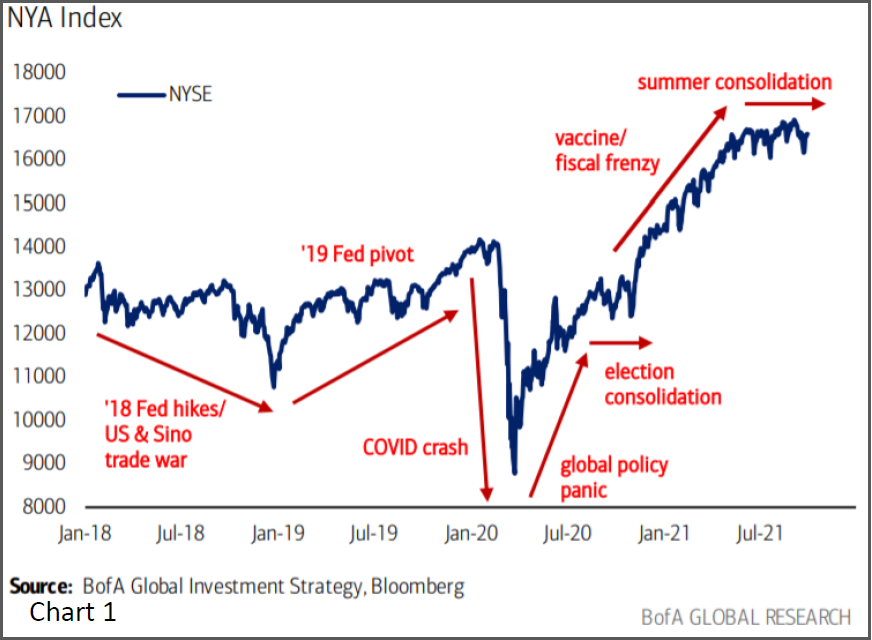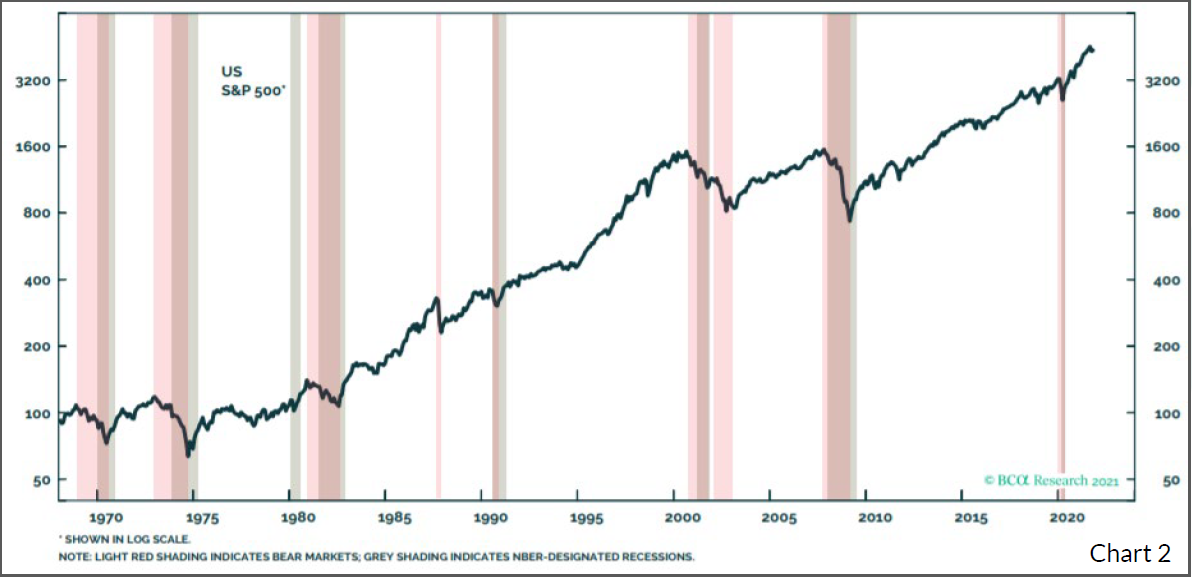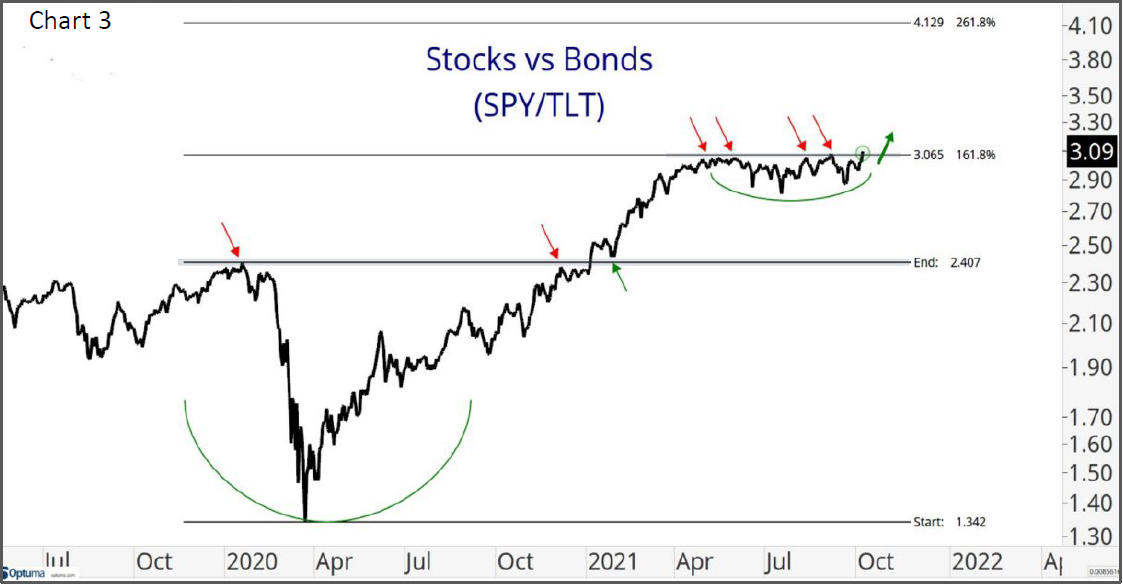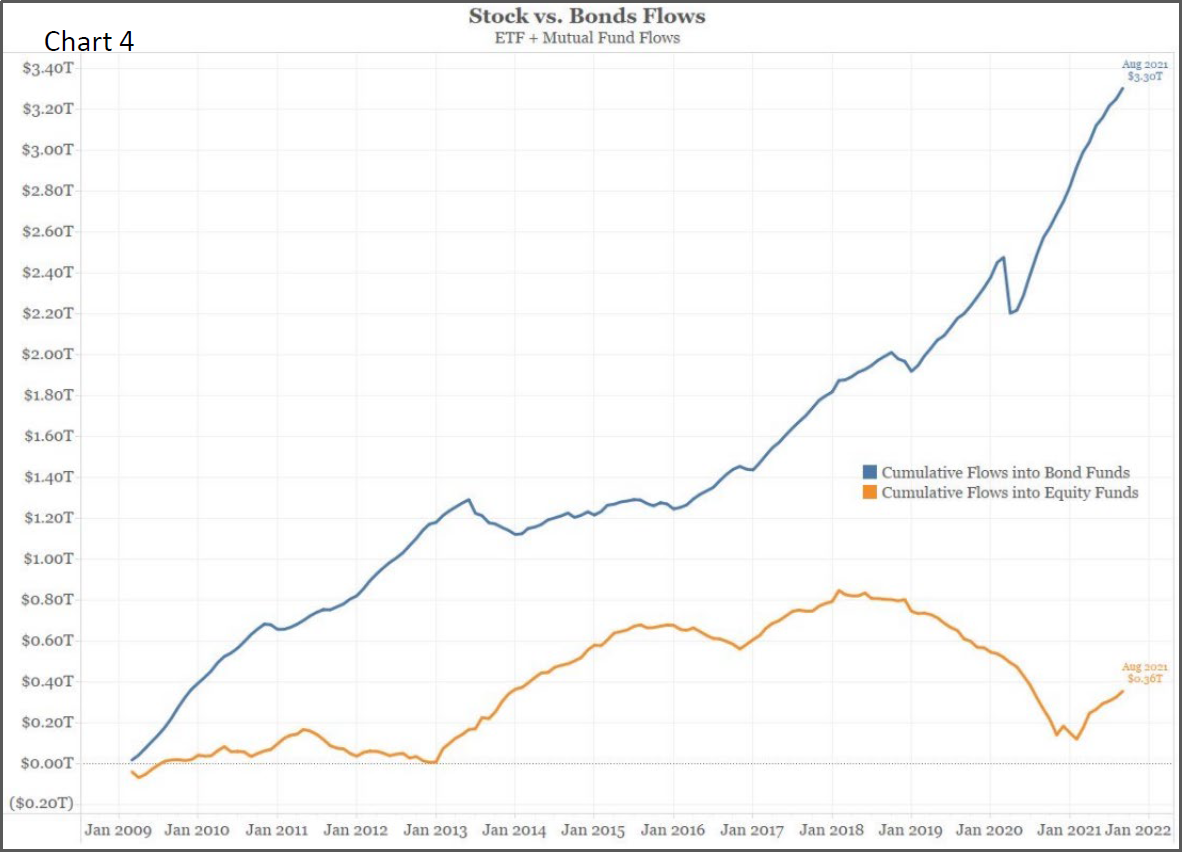The seasonal market weakness that has historically dogged investors in September put a damper on the third quarter rally. As we head into the final quarter of the year, there are a mounting number of headwinds (or narratives) threatening to slow the recovery from the pandemic recession. Stagflation, delta variant, energy shortages, US debt crisis, Evergrande crisis, Fed tightening … to name a few. We addressed some of these concerns directly in our last Markets in Motion… but now we want to focus on the bigger picture. Faced with this catalogue of woes, the stock market setbacks in September are hardly surprising. But with major indices only ~5% off their September all-time highs, is the worst still to come?
While no one can rule out more downside in the days ahead, we believe most risks are either already discounted, exaggerated, transient or irrelevant to equity prices. And broadly speaking (entire NYSE), while it may not feel like it, most stocks have gone nowhere for the past 5 months. (Chart 1).
And as we’ve highlighted in the past with other market narratives, the business cycle is by far the most important driver of equity returns over intermediate-term horizons. So where are we in the business cycle?
We believe global growth has peaked, but at very high levels. Progress on the vaccination campaign, along with continued accommodative monetary and fiscal policies, should keep growth above trend and recession risks at bay for the foreseeable future. This means there is a strong chance stocks and other risk assets continue to make new highs as recession risks remain low. (Chart 2)
Therefore, our portfolios remain overweight stocks. As previously noted, the risk-reward profile for equities is not as appealing as it was last year, but the TINA theme (There is no alternative to equities) will continue to resonate with investors. After all, money flows to where its treated best and after consolidation, stocks are breaking out against bonds. (Chart 3). We believe this rotation from bonds to stocks is just beginning to play out after a decade of flows into bonds. (Chart 4).
This month, we added to risk assets after de-risking before September. We initiated a position in Global natural resource equities to take advantage of a cyclical upswing. Additionally, we initiated a position in local currency emerging market bonds where we see attractive yields and a mean reversion opportunity.
Finally, know that all our Strategies will adapt to fundamental or rules-based, not emotional influences. We seek opportunities for solid risk adjusted returns and to preserve capital in asset market downturns.
Recent Portfolio Changes
We exited our position in Intermediate Treasuries and reduced exposure in Gold to initiate positions in global resource equities and local currency emerging market bonds. We trimmed tactical risk-off positions to take advantage of a rotation back to cyclical assets.
1 Information as of 09/21/2021. Individual account allocations may differ slightly from model allocations.
You can get more information by calling (800) 642-4276 or by emailing AdvisorRelations@donoghueforlines.com. Also, visit our Sales Team Page to learn more about your territory coverage.
John A. Forlines III
Chief Investment Officer
Past performance is no guarantee of future results. The material contained herein as well as any attachments is not an offer or solicitation for the purchase or sale of any financial instrument. It is presented only to provide information on investment strategies, opportunities and, on occasion, summary reviews on various portfolio performances. The investment descriptions and other information contained in this Markets in Motion are based on data calculated by Donoghue Forlines LLC and other sources including Morningstar Direct. This summary does not constitute an offer to sell or a solicitation of an offer to buy any securities and may not be relied upon in connection with any offer or sale of securities.
The views expressed are current as of the date of publication and are subject to change without notice. There can be no assurance that markets, sectors or regions will perform as expected. These views are not intended as investment, legal or tax advice. Investment advice should be customized to individual investors objectives and circumstances. Legal and tax advice should be sought from qualified attorneys and tax advisers as appropriate.
The Donoghue Forlines Global Tactical Allocation Portfolio composite was created July 1, 2009. The Donoghue Forlines Global Tactical Income Portfolio composite was created August 1, 2014. The Donoghue Forlines Global Tactical Growth Portfolio composite was created April 1, 2016. The Donoghue Forlines Global Tactical Conservative Portfolio composite was created January 1, 2018.
Results are based on fully discretionary accounts under management, including those accounts no longer with the firm. Individual portfolio returns are calculated monthly in U.S. dollars. These returns represent investors domiciled primarily in the United States. Past performance is not indicative of future results. Performance reflects the re-investment of dividends and other earnings.
Net returns are presented net of management fees and include the reinvestment of all income. Net of fee performance was calculated using a model fee of 1% representing an applicable wrap fee. The investment management fee schedule for the composite is: Client Assets = All Assets; Annual Fee % = 1.00%. Actual investment advisory fees incurred by clients may vary.
The Donoghue Forlines Global Tactical Allocation Benchmark is the HFRU Hedge Fund Composite. The HFRU Hedge Fund Composite USD Index is designed to be representative of the overall composition of the UCITS-Compliant hedge fund universe. It is comprised of all eligible hedge fund strategies; including, but not limited to equity hedge, event driven, macro, and relative value arbitrage. The Blended Benchmark Conservative is a benchmark comprised of 80% HFRU Hedge Fund Composite and 20% Bloomberg Barclays Global Aggregate, rebalanced monthly. The Blended Benchmark Growth is a benchmark comprised of 80% HFRU Hedge Fund Composite and 20% MSCI ACWI, rebalanced monthly. The Blended Benchmark Income is a benchmark comprised of 60% HFRU Hedge Fund Composite and 40% Bloomberg Barclays Global Aggregate, rebalanced monthly.
The MSCI ACWI Index is a free float adjusted market capitalization weighted index that is designed to measure the equity market performance of developed and emerging markets. The HFRU Hedge Fund Composite USD Index is designed to be representative of the overall composition of the UCITS-Compliant hedge fund universe. It is comprised of all eligible hedge fund strategies; including, but not limited to equity hedge, event driven, macro, and relative value arbitrage. The underlying constituents are equally weighted. The Bloomberg Barclays Global Aggregate Index is a flagship measure of global investment grade debt from twenty-four local currency markets. This multi-currency benchmark includes treasury, government-related, corporate and securitized fixed-rate bonds from both developed and emerging markets issuers.
Index performance results are unmanaged, do not reflect the deduction of transaction and custodial charges or a management fee, the incurrence of which would have the effect of decreasing indicated historical performance results. You cannot invest directly in an Index. Economic factors, market conditions and investment strategies will affect the performance of any portfolio, and there are no assurances that it will match or outperform any particular benchmark.
Policies for valuing portfolios, calculating performance, and preparing compliant presentations are available upon request. For a compliant presentation and/or the firm’s list of composite descriptions, please contact 800‐642‐4276 or info@donoghueforlines.com.
Donoghue Forlines LLC is a registered investment adviser with United States Securities and Exchange Commission in accordance with the Investment Advisers Act of 1940. Registration does not imply a certain level of skill or training.










